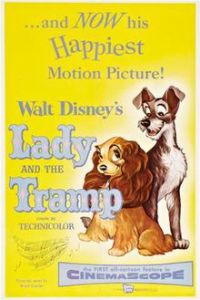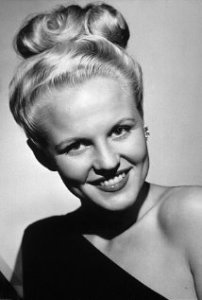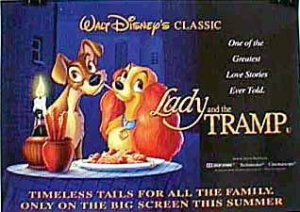Lady and the Tramp ***** (1955, voices of Barbara Luddy, Larry Roberts, Peggy Lee, George Givot, Stan Freberg) – Classic Movie Review 2221
Directors Hamilton Luske, Clyde Geronimi and Wilfred Jackson’s 1955 Disney animated feature is the story of a female American pedigree Cocker Spaniel named Lady who lives with a refined, upper-middle-class family, and a male stray mutt mongrel named the Tramp. When the two dogs meet, they embark on many adventures as Tramp helps Lady helps when she’s in trouble with a pair of Siamese pussy cats (Si and Am, both voiced by Peggy Lee). And they embark on romance, too, when he falls for her.
Based on the story Happy Dan, The Whistling Dog by Ward Greene, it was released to cinemas on 22 June 1955 by Buena Vista Distribution. Disney’s sweet and lovable classic cartoon from their early golden period has a screenplay by Joe Grant, Dick Huemer and Louis Pollock, based on the screen story by Erdman Penner, Joe Rinaldi, Ralph Wright and Don DaGradi. Not the least of its delights are the songs by Peggy Lee and Sonny Burke, and Peggy Lee’s singing of the cute and appealing songs (‘He’s a Tramp’, ‘We Are Siamese’) and voicing of four characters (Si/Am/Darling/Peg).
Barbara Luddy voices Lady, Larry Roberts the Tramp, while George Givot has one of the best moments as Tony the restaurateur trilling the romantic ‘Bella Notte’. Also in the voice cast are Bill Thompson as Jock, Joe, Bulldog, Dachsie and Policeman, Verna Felton as Aunt Sarah, Stan Freberg as the beaver, Lee Millar as Jim Dear the dogcatcher, Alan Reed as Boris, Thurl Ravenscroft as Al the alligator, Bill Baucom as Trusty and Dallas McKennon as Toughy, Pedro, Professor and Hyena.
The 15th film in the Walt Disney Animated Classics series, it was the first animated feature filmed in the CinemaScope widescreen format and was a first for the Walt Disney studio, though it was planned in a regular ratio. The CinemaScope widescreen images seem a mistake in a Fifties cartoon, but at the time the studio thought it necessary to combat the threat of TV. The extra width creates more realism but offers chances for fewer close-up shots of the characters, makes it difficult for a single character to dominate the screen so groups of characters are spread out to keep the screen seeming busy, and longer takes are needed to avoid annoying jump-cutting. Not all cinemas could show CinemaScope so Walt Disney had to prepare one version in widescreen and another in the regular ratio.
Nevertheless, the painstakingly and lovingly created Technicolor images are perfect though in an adorable and highly successful film. It took more than any other Disney animated feature since Snow White and the Seven Dwarfs, earning an estimated $7.5 million in rentals at the North American box office in 1955. It was re-released in 1962, 1971, 1980 and 1986. It was remastered and restored for DVD as the seventh instalment of Disney’s Platinum Editions series. One million copies were sold on release on February 28 2006.
The animators studied many dogs of different breeds to capture the movement and personality of dogs. Although the sequence of the dogs eating spaghetti is now the best known in the film, Walt Disney was prepared to cut it until animator Frank Thomas showed him it could be romantic and not silly.
It is followed by a very belated made-for-video sequel: Lady and the Tramp II: Scamp’s Adventure directed by Darrell Rooney and Jeannine Rousel in 2001, in which Lady (voice of Jodi Benson) and the Tramp (voice of Jeff Bennett) are proud but controlly parents of a litter of pups.
© Derek Winnert 2015 Classic Movie Review 2221
Check out more reviews on http://derekwinnert.com/









